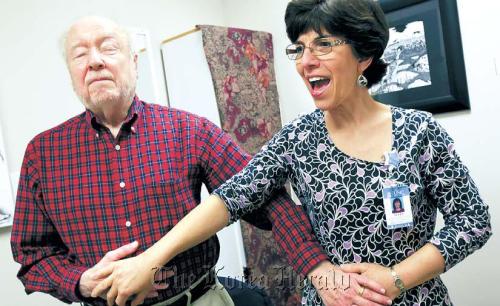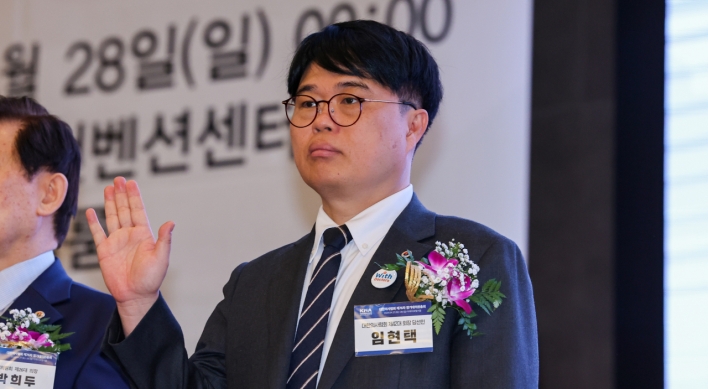CHAPEL HILL, N.C. ― Aging baby boomers have long used exercise, surgery and collagen as they try to slow the natural bodily processes of aging.
Now, some are flocking to do the same with something that’s usually a dead giveaway: a voice that sounds “old.”
Research shows that older peoples’ voices often develop breathiness, weakness and loss or range or quality from causes that include disease, changed use of their voices, and the condition called presbylaryngis, also known as “aging of the larynx.”
As the baby boomers grow old, the estimated 30 percent of older folks with speech disorders will roughly double over the next two decades. Those born between 1946 and 1964 will likely object even more than today’s patients to a lessened ability to speak and be heard clearly, said Dr. Robert Buckmire, a University of North Carolina Chapel Hill otolaryngologist.
“There’s a significant social cost to not being able to communicate,” said Buckmire, who works with a team that includes speech therapist Ellen Markus.
“Our age population is more active, they are working, they are more active socially. There’s a much higher stake in the effectiveness of the voice for personal and professional reasons than there was five or 10 years ago.”
From precise vocal-function exercises to laryngeal surgery to collagen injections that plump thinning vocal cords, doctors and therapists use a variety of approaches to ward off the effects on aging of patients’ voices.
Self-image, basic communication and professional reputation are at stake for the increasing number of patients who have sought help from the UNC Voice Center and other medical facilities. An often-cited study from the ‘90s found that listeners tended to rate an older voice as “doddery,” “vague,” and “rambling,” while giving more credibility to the same words from a younger speaker.
Now, some are flocking to do the same with something that’s usually a dead giveaway: a voice that sounds “old.”
Research shows that older peoples’ voices often develop breathiness, weakness and loss or range or quality from causes that include disease, changed use of their voices, and the condition called presbylaryngis, also known as “aging of the larynx.”
As the baby boomers grow old, the estimated 30 percent of older folks with speech disorders will roughly double over the next two decades. Those born between 1946 and 1964 will likely object even more than today’s patients to a lessened ability to speak and be heard clearly, said Dr. Robert Buckmire, a University of North Carolina Chapel Hill otolaryngologist.
“There’s a significant social cost to not being able to communicate,” said Buckmire, who works with a team that includes speech therapist Ellen Markus.
“Our age population is more active, they are working, they are more active socially. There’s a much higher stake in the effectiveness of the voice for personal and professional reasons than there was five or 10 years ago.”
From precise vocal-function exercises to laryngeal surgery to collagen injections that plump thinning vocal cords, doctors and therapists use a variety of approaches to ward off the effects on aging of patients’ voices.
Self-image, basic communication and professional reputation are at stake for the increasing number of patients who have sought help from the UNC Voice Center and other medical facilities. An often-cited study from the ‘90s found that listeners tended to rate an older voice as “doddery,” “vague,” and “rambling,” while giving more credibility to the same words from a younger speaker.

Buckmire keeps all of this in mind when he refers patients such as UNC Chapel Hill retiree Ray Carpenter to the center for therapy. Carpenter is of an older generation than the boomers, but like them wants to stay communicative.
“I am dealing with voice problems, hearing problems and vision problems, but I’m smart as a whip,” joked Carpenter, 85, as he began a session Monday in Markus’ office at the Voice Center.
Markus, a graduate of the prestigious Eastman School of Music, works daily with both singers and talkers on the three elements that produce vocal sound: the respiratory system, or the breath behind the sound; the vocal cords, which open and close to produce sound and the resonance system _ the throat, tongue, teeth and lips _ which amplify and articulate the sound.
“You’ve been practicing; I can tell,” Markus said to Carpenter, whose wife Pat, 73, sat nearby. Therapist and patient got right down to the task in a treatment room.
“OK, let’s say, ‘Hello, he, he,’” she said.
“Now, say ‘Hope he will.’
”’Heap it on. Hit the wall. Hop on.’“
Carpenter dutifully repeated the phrases, emphasizing the ‘h’ sounds as Markus had.
”I want you to use those belly muscles; the belly is supporting all of this,“ she said.
Just as trained singers use their diaphragms, Markus said, Carpenter should be able to feel the organ supporting his lungs as he pushed air upward towards speech. She took him through a series of nonsense syllables designed to improve his volume, tone and endurance.
”I keep exploring, and I make it a little longer,“ she said of one exercise. ”Does it break down as it goes a little longer?
“They’re supposed to be like low-impact aerobics; you shouldn’t be hurting yourself.”
Buckmire, the physician, pointed out that the muscles of the larynx and other organs involved in speech can’t be bulked up by exercise the way the body’s large muscles can.
“When you talk about the voice, there are changes with muscles, change in connective tissue with age, and that’s a very natural change,” he said.
“The larynx, the vocal tract, including the lungs, the throat, the tongue _ there are somewhat predictable changes in all those muscles with age.”
A person recorded at age 30 and again at age 70 will sound noticeably different because of the diminished bulk of the vocal cords, he said. Lung capacity also tends to diminish with passing years, leading to a weaker voice. Sometimes a singer or speaker will produce a breathy sound through vocal cords that aren’t closing properly.
Changes in the brain can bring tremors and other signs of aging. But there’s a bright side to the picture as well.
“Although things change and do age, the voice output is not condemned to change,” Buckmire said.
“When we get to strategies to improve the voice or maintain the voice, it’s about maintaining all processes and gaining endurance. We know that people can successfully sing at a very high level into their eighties, but it takes more technique and practice.”
Vocal quality is closely affected by the suppleness of vocal cords, which can lose elasticity in old age, just as skin does.
“When you change laxity, you change how the voice vibrates,” Buckmire said. “You can’t either stave off the changes, or reverse them. Then we really rely on technique and vocal hygiene, how you use the voice and hydration.”
Learning to energize the voice with more breath and resonance can minimize the effects of aging, he said: “We can relieve the impression of a weak voice, a tired voice.”
By Thomas Goldsmith
(McClatchy Newspapers)
(MCT Information Services)
-
Articles by Korea Herald






![[News Focus] Lee tells Yoon that he has governed without political dialogue](http://res.heraldm.com/phpwas/restmb_idxmake.php?idx=644&simg=/content/image/2024/04/29/20240429050696_0.jpg&u=20240429210658)












